Prediabetes Diet Plan [+Sample Diet Plan Included]

Key Takeways
A diet plan for prediabetes prioritizes non-starchy vegetables, lean protein, and healthy fats. This approach helps manage carbohydrate intake and stabilize glucose responses by pairing carbs with fiber and protein. A simple way to build meals is using the Plate Method.
What to know:
- The Plate Method involves filling half your plate with non-starchy vegetables, a quarter with lean protein, and a quarter with quality carbohydrates.
- See a sample 1,500-calorie meal plan with specific breakfast, lunch, and dinner ideas to help you get started.
- Members can work with a registered dietitian to personalize their plan, with video calls often covered by insurance.
What is Prediabetes and Why Does Diet Matter?
Are your glucose levels often higher than usual? Do you have a genetic predisposition for diabetes but haven't been diagnosed with it yourself? Do you feel tired, have blurred vision, and increased thirst? If any of this sounds familiar, you may want to check with a healthcare professional about prediabetes.
Someone is generally diagnosed with prediabetes when they have higher-than-normal glucose levels, but these levels are not high enough to be considered type 2 diabetes. If you're wondering whether you have prediabetes or diabetes, we encourage you to speak with your doctor.
While prediabetes may be reversible, remember that it's not a benign condition. Many people assume that prediabetes is not severe because they do not yet have diabetes. But according to the CDC, when someone is diagnosed with prediabetes and doesn't take any action (medication or lifestyle changes), there is a good chance they will develop diabetes within five years.
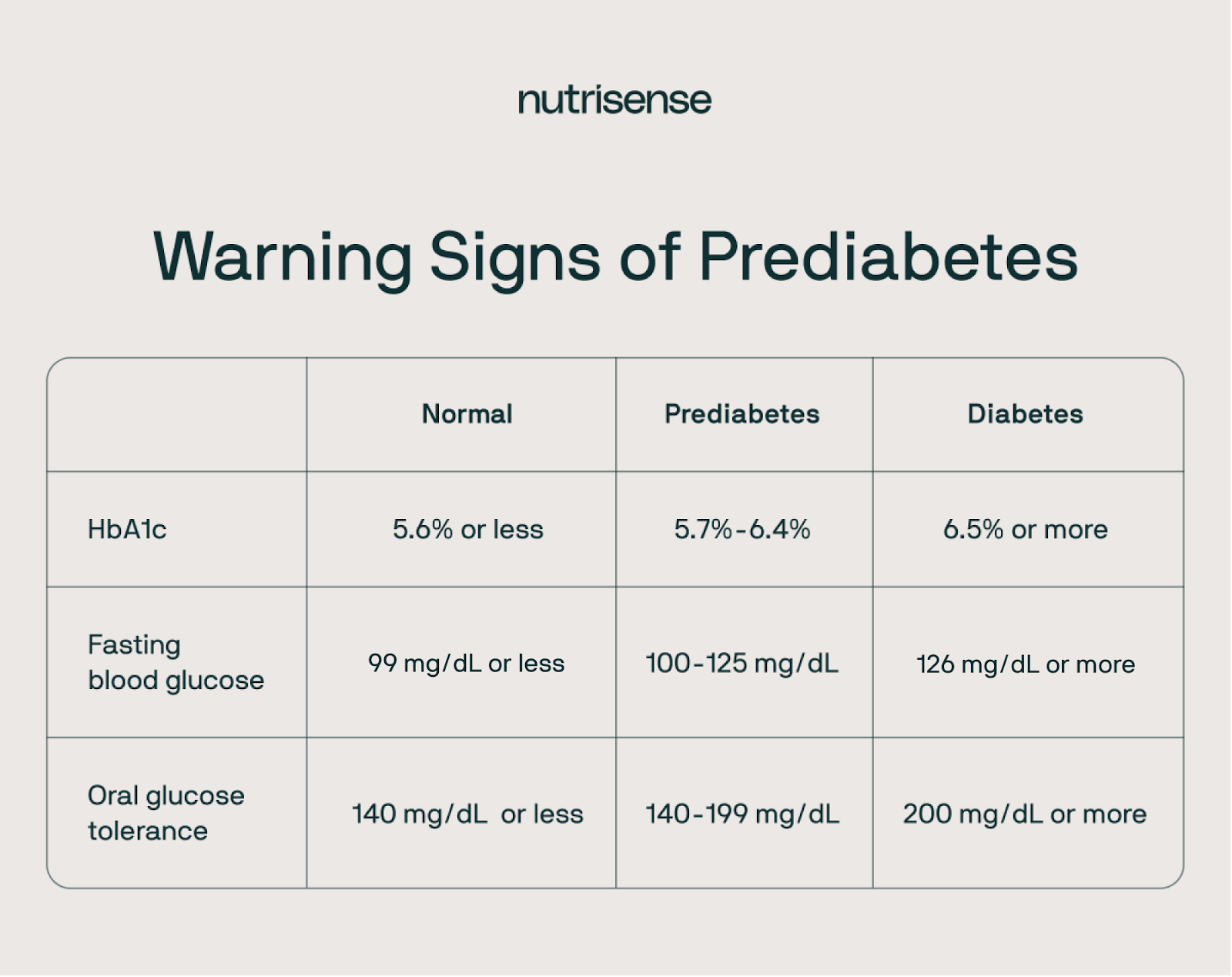
Insulin Resistance Basics
People with prediabetes have higher-than-normal glucose levels, but this is a simplistic view of the condition. The pathophysiology of prediabetes is more complex, with the condition often beginning with insulin resistance within the body's cells.
Pancreas and Insulin
This means that when you eat carbohydrates, you have to release more insulin to overcome the insulin resistance in your cells. Think of insulin as a key that allows glucose to move into your cells. Your pancreas secretes insulin from what’s known as Beta cells.
Which Lifestyle Changes Reduce Diabetes Risk?
Over time, your pancreas cannot keep up with the increased need for insulin, and glucose levels start to rise. Remember, although you can't control genetics or family history, there are factors within your control, including your weight, activity levels, and diet.
Still, data from the Diabetes Prevention Program is promising. It focused on participants who were encouraged to make healthy changes to their diet and increase activity. The results found that people diagnosed with prediabetes could reduce their risk of diabetes by 58 percent with specific lifestyle changes. These included improving their diet and starting an exercise program to lose at least five percent of their body weight.
Some of the dietary changes, in particular, included reducing processed foods, eating more fruits and vegetables, and being mindful of food intake. So, are you wondering how to incorporate some of these, but don't know where to start? This article shares specifics on some foods that may help lower diabetes risk and others to consider limiting in your diet.
From Mealtime Guesswork to a Clear Plan
You stand in the kitchen after work, trying to decide what to make. You followed the "rules" for a healthy lunch with a big salad and grilled chicken, but that familiar afternoon energy dip still hit you hard.
Now you’re looking at the ingredients for dinner, and the questions start again. Is this the right amount of quinoa? Should you eat the apple now or later? The constant second-guessing is draining, and you wish you had a clear, simple way to know what your body actually needs to feel steady and energized.
Tips for Healthy Eating if You Have Prediabetes

Whether you know you have prediabetes or suspect you may be at risk, it's a good idea to see what you should and shouldn't include in your diet. Read on for tips and tricks to maintain a healthy, prediabetes-preventive diet.
The Plate Method and Carbohydrate Counting
A clear framework can make meals simpler. Try the Plate Method to portion without measuring: fill half your plate with non-starchy vegetables, one quarter with lean protein, and one quarter with quality carbohydrates, plus a small amount of healthy fat. Use it at home or when eating out to keep portions consistent.
If you prefer Carbohydrate Counting, set a target carbohydrate range per meal and per snack that fits your needs. Use the Nutrition Facts label to count total carbohydrate grams per serving and track portions. Adjust based on activity, satiety, and guidance from your clinician or a registered dietitian.
- Quick visual cues for portions when you are not measuring: protein about a palm, carbs about a cupped hand, fats about a thumb, non-starchy vegetables about two fists.
- Make it personal with data. If you use a glucose biosensor, log meals in the Nutrisense App to compare your plate with your 24/7 glucose patterns measured in interstitial fluid.
- Want 1:1 help setting a starting carb range or building plates for your routine? Check your eligibility for insurance-covered video calls with a Nutrisense dietitian.
Eat More Non-Starchy Vegetables
Non-starchy vegetables are lower in carbohydrates than their starchy counterparts. Some starchy vegetables include potatoes (all types, including sweet potatoes), corn, beans, lentils, peas, yams, and winter squash (acorn, pumpkin, and butternut).
Non-starchy vegetables include carrots, Brussels sprouts, leafy greens, broccoli, mushrooms, tomatoes, peppers, onions, and beets. But why pick them?
Why Choose Non-Starchy Veggies?
Non-starchy vegetables are full of nutrients, including vitamins, minerals, phytochemicals, and antioxidants. Inflammation is a key factor in diabetes, so eating a diet that can help reduce inflammation can be a helpful way to lower risks.
In addition, they have both insoluble and soluble fiber, which can fill you up without adding extra calories to your diet. It also aids in digestion and provides prebiotics, enhancing your gut microbiome.
The Gut–Metabolism Link
There is increasing research about the link between the gut microbiome and diabetes. It suggests that a healthy gut microbiome may help reduce your risk of developing diabetes.
Another thing to note is that Americans don't have enough vegetables in their diet. The current recommendations are around two to three cups of non-starchy vegetables per day, but a larger amount (approximately three and a half to five cups daily) is likely better for most people!
Add Nuts and Seeds to Your Diet
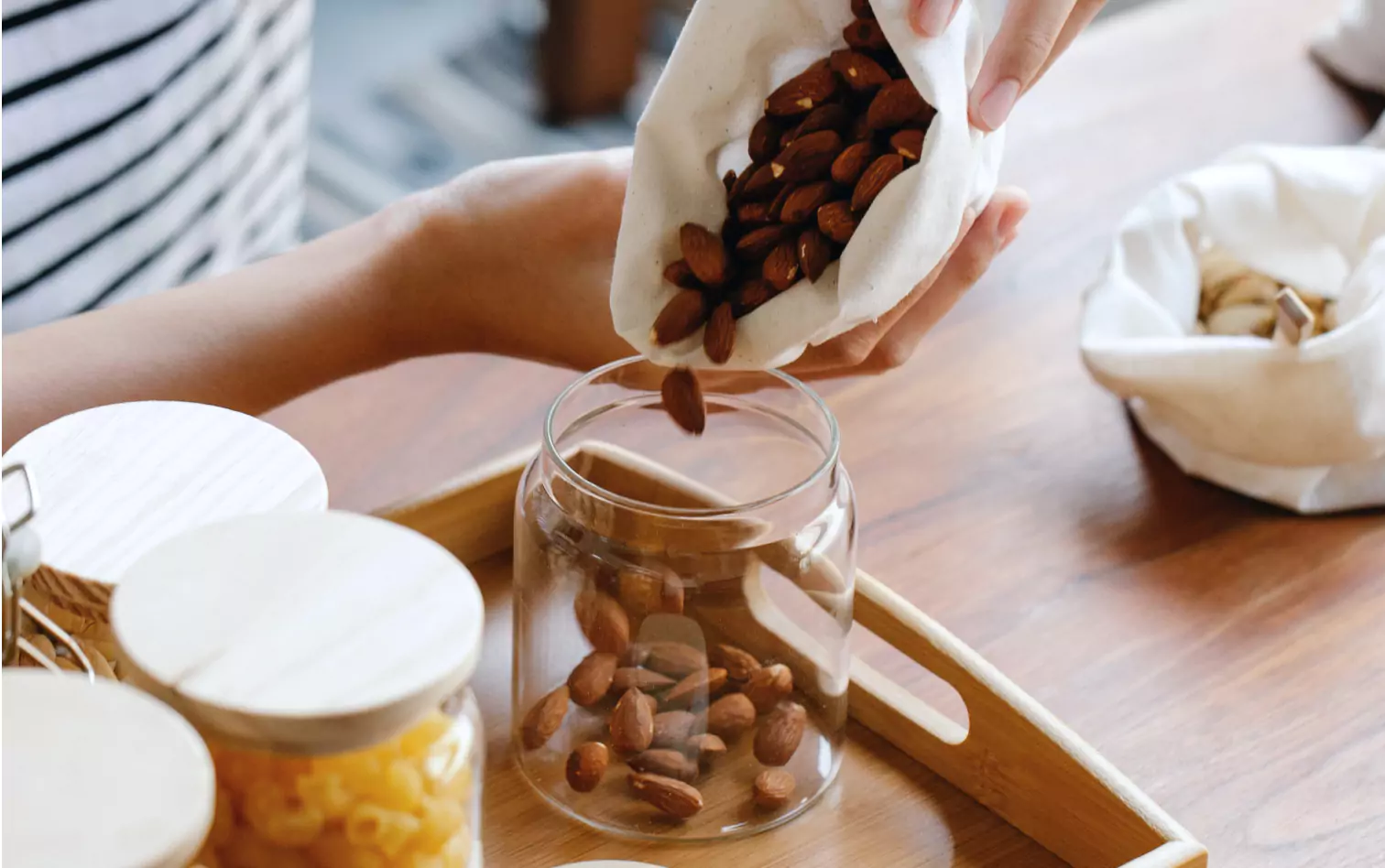
Do you eat enough nuts and seeds daily? If not, you may want to consider adding them to your diet. Nuts include almonds, walnuts, pecans, Brazil nuts, macadamia nuts, and pistachios. Seeds include pumpkin, chia, flax, sunflower, hemp seeds, and sesame seeds.
Both are nutrient-rich foods that can help with a prediabetic-preventive lifestyle. Seeds, in particular, contain healthy monounsaturated fats and polyunsaturated fats. They're also a good source of fiber and contain vitamins, minerals, phytochemicals, and antioxidants—all part of a healthy diet. There is also evidence that nuts and seeds can improve cardiovascular health and may help lower the risk of type 2 diabetes.
Try Food that is Low on the GI Scale
The glycemic index (GI) is a value used to determine how much a food increases glucose. It's measured on a scale from 0-100, with 100 being pure glucose. If food is lower on the GI scale, it will likely have a lower glucose response for most people.
This lower response is good news for people with prediabetes, who may have decreased insulin sensitivity. Here is a helpful tool to look for the glycemic index of specific fruits and vegetables.
Processed grains such as white bread, white rice, and pastries are higher in GI. Low GI foods are typically those non-starchy vegetables, such as broccoli or asparagus, that we mentioned adding to your diet. It's also possible to combine certain foods to lower your post-prandial responses.
For example, combining a high-GI food with protein and/or fat is a good idea. It can help slow your digestion and may reduce your glucose response. Another option is eating the protein food first, followed by the higher GI food.
Remember that portion size does matter here, so the protein likely won't help if your portion of the high-GI food is larger.
Eat More Food That is Rich in Fiber
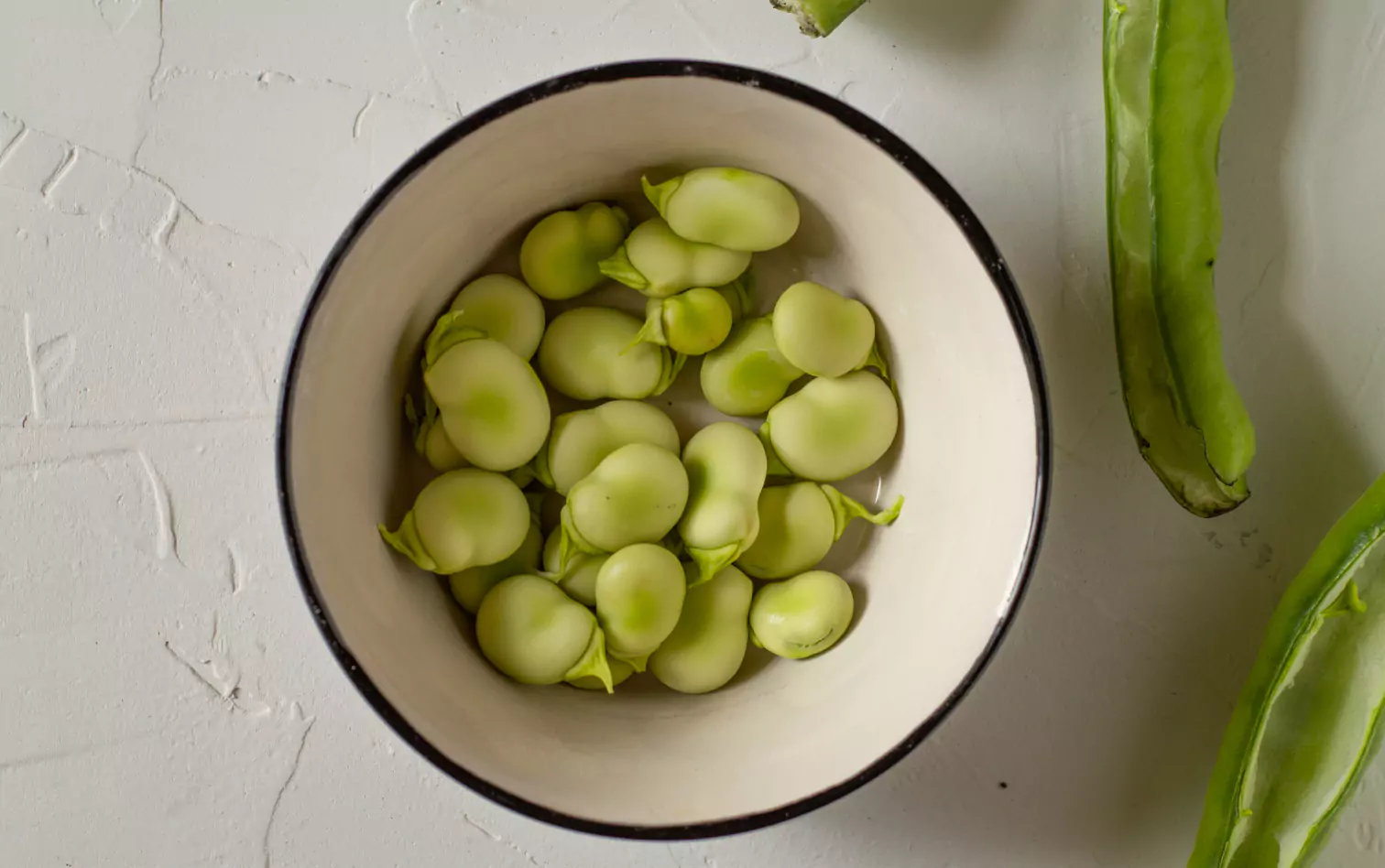
Fiber is also known for slowing down digestion, and it adds bulk to the foods we eat. Because fiber is not digested in your small intestine, it does not contribute to the calories you eat. Because fiber is not digested like other types of carbohydrates, it is subtracted from total carbohydrates when referencing 'net’ carbs.
Adding foods higher in fiber to your daily meals may help improve cardiovascular health and possibly reduce your risk of developing diabetes.
High-fiber foods include beans, lentils, non-starchy vegetables, nuts, and seeds, some fruits, and whole grains like oatmeal, quinoa, and barley. Studies show fiber reduces cholesterol, fasting glucose, and hemoglobin A1C.
Have Whole Fruit Paired with Protein as a Snack if Needed
Fruits are a good source of vitamins, phytochemicals, and antioxidants, and are also full of fiber. Fruits also contain sugar, which can increase glucose levels, so it's essential to consider the type of fruit, how you prepare it, and how much of it you eat. Good choices include berries, melon, apples, and oranges, as they are higher in fiber.
It's best to limit your fruit juice intake because all the fiber is processed from it, and it's much higher in sugar. For instance, an eight-ounce glass of orange juice can contain the same amount of sugar as two to three oranges. Dried fruit can also be challenging because it becomes more concentrated in sugar when the water is taken out.
Remember that one-fourth cup of raisins contains about the same sugar as a cup of grapes. Dried fruit (like dried cranberries and dried mango) often has sugar added to increase the sweetness. If you have dried fruit, try to find the kind without added sugar, and be mindful of your portion size.
Pairing fruit with protein as a snack or using a portion of fruit as your carbohydrate choice with a meal could be great options for incorporating fruit into your diet. The protein helps slow digestion and may help decrease your glucose response from the fruit in that meal or snack.
Limit Grazing and Snacking

Snacks aren't all bad, but limiting the amount of snacking throughout the day is best. A certain amount of insulin is released each time you eat, which increases if your meal contains carbohydrates. Meals high in protein lead to the release of small amounts of insulin.
When you're looking to preserve pancreatic function and its ability to release insulin, giving the pancreas some time between meals is crucial. If you're constantly snacking, your pancreas has to work that much more often to release insulin!
Enjoy Good Quality Protein Sources
Protein does not raise the glucose levels in your blood, so it's a good choice for people with prediabetes. Also, pairing a good-quality protein with carbohydrates can help decrease your glucose response to the carbs. It's because protein takes longer to digest and can slow the digestion of carbohydrate-rich food.
Protein-rich foods include meat, poultry, fish, dairy products (cheese, cottage cheese, yogurt), eggs, and tofu/tempeh. Remember: some protein-rich foods also contain carbohydrates, including beans and lentils or grains such as quinoa. Nuts and seeds have some protein, but something to consider is that some nuts are higher in carbs than others!
Practice Meal Sequencing

According to some research, eating your protein before your starch or carbohydrates can improve your glucose response and may even help suppress appetite. For example, consider a meal with steak, Brussels sprouts, and potatoes. In this situation, you would want to eat the steak first, then Brussels sprouts (non-starchy vegetables), and finally, the potatoes.
Hydrate, Hydrate, Hydrate!
When you're dehydrated, it can increase the glucose concentration in your blood. A study links dehydration with glucose dysregulation in normal healthy adults, for example.
Some research also indicates that chronic low water intake can increase the risk of elevated glucose and possibly even diabetes. So, staying hydrated can be critical with or without prediabetes.
The daily fluid requirement is probably more than the eight-glass recommendation you've likely heard. And your need for fluid also increases if you live in hot and humid environments. According to Mayo Clinic recommendations, men require 15.5 cups of fluid daily, and women need 11.5 cups.
If you have a hard time knowing what 'enough' is when it comes to your water intake, try using a water bottle throughout the day to measure how many ounces you’re drinking. Also, consider flavoring your fluids with a bit of lemon or non-sugar-containing flavoring.
If you like carbonated beverages, try seltzer water. While tea and coffee contain fluids, caffeinated drinks can also be considered a diuretic, increasing urination.
Watch Out for Added Sugars and Refined Carbohydrates

Many processed foods contain added sugars. It may even be present in dried fruit, pasta sauce, and canned soups. So, looking at the label to see if your food contains added sugars is vital. You'll be surprised how much of it does!
Food packaging can also be deceptive. Things labeled as containing whole grains (like flavored instant oatmeal) can also be full of added sugars. It's also why you should look at the nutrition facts label and ingredient list. Is the first ingredient a whole grain? If not, it's likely not a good choice.
Also, watch out for refined carbohydrates—mostly refined grains—which means all healthy ingredients (including fiber and nutrients) are missing. Refined carbs can increase the food's glycemic index, leading to a more significant glucose response.
Discover Your Personal Carbohydrate Threshold
Everyone responds differently to carbohydrates. In addition, glucose responses may vary for different types of carbohydrate foods. The carb threshold for a meal can also depend on other factors, including how active you are or what food you ate before the meal.
It might be a good idea to find your specific carbohydrate threshold or the amount of carbs you can tolerate without having a larger glucose response. You can do this with a finger-stick device, measuring your glucose around one or two hours post-meal. Still, there are limitations to this method as it does not give you the complete picture.
An excellent way to check how you respond is with a continuous glucose monitor, or CGM. A CGM will help you see if you have a more considerable glucose spike with a meal containing carbs and how quickly your values return to baseline.
{{rich-text-cta-wl2="/style-guide"}}
Prediabetes Diet Plan to Use (1,500 calories)
Everyone has unique dietary and energy needs, so this is just a sample plan, but it can be a good starting point if you are looking for some ideas! For some helpful prediabetes ideas, here’s a meal plan put together by Nutrisense dietitian Katie Kissane, MS, RD.
Breakfast

Breakfast parfait with a cup of plain Greek yogurt, 1⁄2 cup of blueberries, two tablespoons of walnuts, and one tablespoon of seeds such as chia, sunflower seeds, or flax seeds. Add an optional 1⁄4 teaspoon of cinnamon.
Nutrition: 360 calories, 29 grams of protein, 24 grams of carbohydrates, 18 grams of fat
Snack
Two egg muffins.
Nutrition: 200 calories, 16 grams of protein, 8 grams of carbohydrate, 12 grams of fat
Lunch
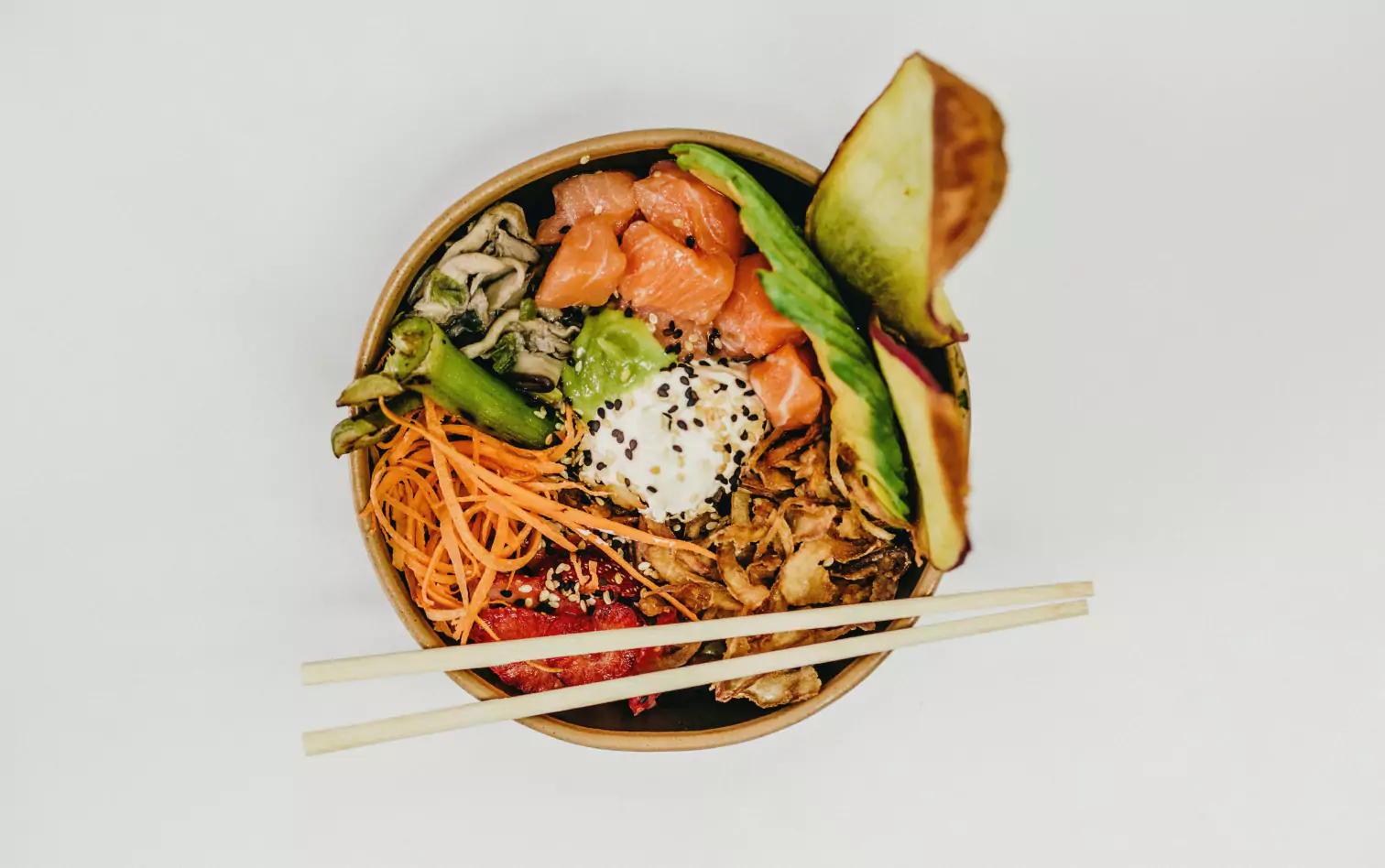
A salmon salad with four ounces of salmon (grilled, baked, or smoked), two cups of leafy greens, 1⁄4 cup of sliced cucumbers, seven cherry tomatoes, and a diced carrot. Add a Balsamic vinaigrette dressing made with olive oil, and eat it with a serving of almond crackers (our favorites are the ones from Simple Mills).
Nutrition: 522 calories, 38 grams of protein, 37 grams of carbohydrates, 25 grams of fat
Dinner

Three to four ounces of lean chili lime flank steak or 1 cup of marinated and scrambled tofu, one cup of cilantro-lime cauliflower, 1⁄2 cup of black beans, 1⁄2 an avocado, sliced.
Nutrition: 440 calories, 36 grams of protein, 33 grams of carbohydrates, 19 grams of fat
Total: 1,522 calories, 119 grams protein, 100 grams carbohydrates, 74 grams fat
Try These Recipes
From a delicious flank steak to some roasted cauliflower and some delicious egg muffins, your prediabetic meal plan can be healthy and tasty. Here are a few of Kissane's favorites, with some modifications, so you can start your meal planning on a delicious note!
Chile Lime Flank Steak

Ingredients:
- 3 tablespoons lime juice
- 1 teaspoon raw honey
- 2 cloves garlic, minced
- 1 teaspoon ground chile pepper
- 1 tablespoon dried cilantro or 1⁄4 cup fresh cilantro
- 1 pound flank steak, trimmed
To make:
- Combine lime juice, honey, garlic, chipotle pepper, and cilantro in a large zip-top plastic freezer bag; add steak.
- Seal and chill for four hours or overnight.
- Preheat broiler. Remove steak from marinade; discard marinade, then place the steak on a rack rubbed with oil in a broiler pan.
- Broil for five minutes per side or to desired doneness.
- Let it stand five minutes before thinly slicing across the grain.
Pro Tip: You can also use chicken thighs instead of the flank steak.
Cilantro-lime Roasted Cauliflower
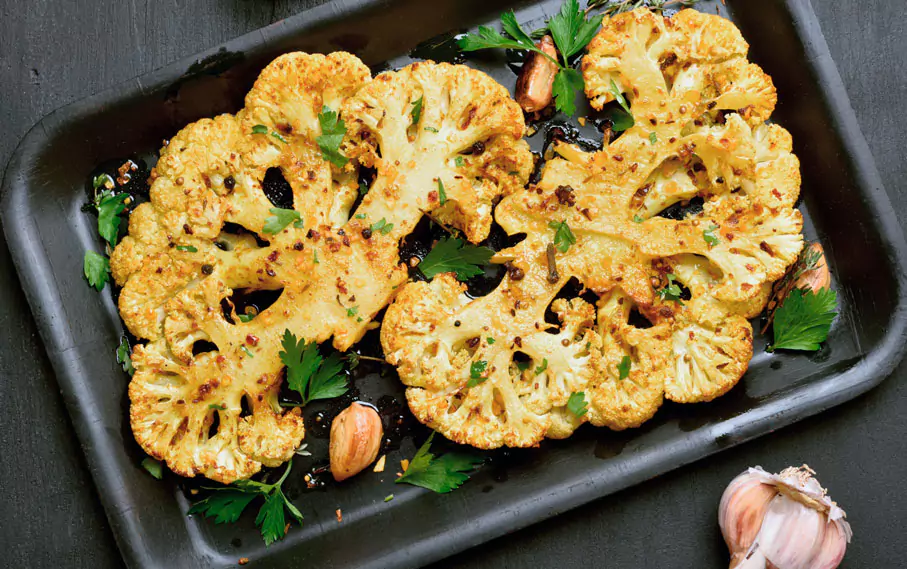
Ingredients:
- 2-3 cups of cauliflower florets (from 1 pound of cauliflower)
- 1 garlic clove, minced
- 1 tablespoon olive oil
- 1 teaspoon cumin
- Sea salt to taste
- 1⁄4 cup crushed red pepper flakes or cayenne pepper
- 1 teaspoon of lime juice
- 1 teaspoon lime zest
- 1 tablespoon chopped cilantro
To make:
- Preheat oven to 450 degrees F.
- Place cauliflower florets and minced garlic on a large rimmed baking sheet and drizzle with olive oil.
- Season with cumin, salt, and crushed red pepper or cayenne pepper, and toss the cauliflower until coated.
- Bake in the center of the oven until lightly browned and tender, about 25-30 minutes, turning the florets occasionally until evenly cooked.
- Remove from the oven, squeeze lime juice on top, add lime zest and cilantro, and serve warm.
Egg Muffins
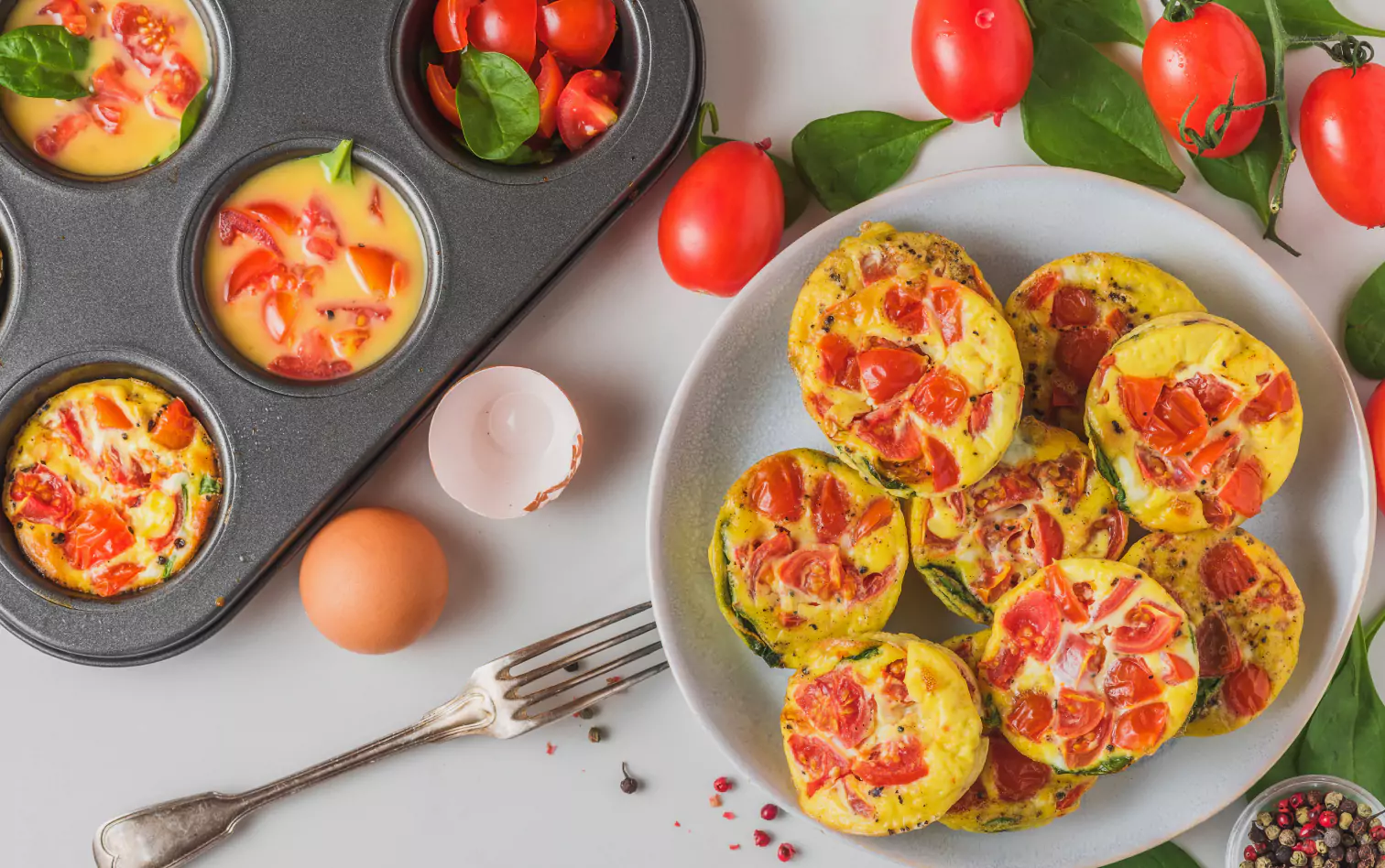
Ingredients:
- 1 bell pepper
- 3 green onions, sliced
- 1-2 tomatoes
- 6 eggs
- A handful of spinach/ leafy greens
- 1⁄4 cup of shredded Monterey Jack or cheddar cheese
- 1⁄2-1 teaspoon sea salt
- 4-5 splashes of hot sauce
Equipment:
- 6 slot muffin tin (double that if you double the recipe)
- Muffin cups or nonstick cooking spray
To make:
- Preheat the oven to 390 degrees F.
- Wash and dice the pepper, onion, and tomatoes, and put them in a large mixing bowl.
- Wash the spinach, lightly chop it, and add it to the bowl as well.
- Add the eggs and salt. Mix well.
- Grease the muffin tin with oil and kitchen paper/baking brush, and pour the egg mixture evenly into the muffin slots. (If you think they might still stick to the pan, use some muffin cups or cut out some baking paper to use as cups - definitely saves time cleaning up!)
- Layer cheese on the egg mixture before you put it in the oven
- Pop the tray into the oven for 15-18 minutes or until the tops are firm to the touch.
Pro Tip: Crack the egg separately before adding it in. So, if you get a dodgy egg, it won't ruin the entire meal. You can also optionally add some hot sauce.
Find the right Nutrisense programto turn insight into progress.
Prediabetes diet plan FAQs
Q1. How do I use a CGM with Nutrisense to personalize my carbohydrate portions?
A1. Use Nutrisense to test your carbohydrate tolerance. Wear the biosensor to see glucose measured in interstitial fluid and log meals in the app. Repeat the same meal with different portions or sequencing and compare the peak and how quickly values return toward your pre-meal level. Adjust portion size, add protein or fiber, or change timing based on those comparisons.
Source: Nutrisense App
Q2. What should I watch for in my post-meal glucose pattern?
A2. Track three items for each meal: the peak after eating, the time to peak, and the time to return near your pre-meal level. If you see large peaks or slow returns, try smaller portions, add protein or fiber, or eat protein and non-starchy vegetables first. Compare similar meals in the app to see which changes work best for you.
Source: Prediabetes and CGM benefits
Q3. Do I need a prescription to start Nutrisense if I have prediabetes?
A3. In most cases, no prescription is needed. Nutrisense primarily provides over-the-counter Stelo sensors. After signing up, approval usually takes 1 to 2 days, with U.S. shipping that typically arrives in 3 to 5 business days. Each sensor lasts up to 15 days once activated, and the app helps you view patterns and plan experiments with your meals and activity.
Source: How it works
Q4. Are dietitian coaching calls included, and can they help tailor a prediabetes plan?
A4. Yes. Plans include a complimentary first month with a registered dietitian, with options to continue at a discounted rate or through insurance. Your dietitian can review glucose patterns, set up meal experiments, and help you create a practical prediabetes-friendly plan that fits your routines. You can check insurance eligibility online in minutes. Coverage varies by plan.
Source: Nutritionist video calls
Q5. How can I make restaurant meals more supportive of my glucose goals?
A5. Start with protein and non-starchy vegetables, ask for dressings and sauces on the side, and split or box refined starches or desserts. Choose unsweetened beverages. You can test portion and sequencing changes by logging the meal and reviewing your curve in the app. Repeat the order on another day to compare results under similar conditions.
Source:Nutrisense App
Go Beyond Glucose Data with Nutrisense
Your glucose can significantly impact how your body feels and functions. That’s why stable levels are an important factor in supporting overall wellbeing. But viewing glucose isn't enough. Nutrisense, you’ll be able to learn how to use your body's data to make informed lifestyle choices that support healthy living.
One-to-one coaching
Sign up to access insurance-covered video calls to work with a glucose expert: a personal registered dietitian or certified nutritionist who will help tailor your lifestyle and diet to your goals.
Monitor and measure what matters
With the Nutrisense CGM Program, you can monitor your glucose with health tech like glucose biosensors and continuous glucose monitor (CGM)s, and analyze the trends over time with the Nutrisense App. This will help you make the most informed choices about the foods you consume and their impact on your health.
Find your best fit
Ready to take the first step? Start with our quiz to find the right Nutrisense program to help you take control.
Go Beyond Glucose Data with Nutrisense
Your glucose can significantly impact how your body feels and functions. That’s why stable levels are an important factor in supporting overall wellbeing. But viewing glucose isn't enough. With Nutrisense, you’ll be able to learn how to use your body's data to make informed lifestyle choices that support healthy living.
Work with a Dietitian
Sign up to access insurance-covered video calls with a glucose expert: a personal registered dietitian or certified nutritionist who will help tailor your lifestyle and diet to your goals.
Monitor and Learn in the App
With the Nutrisense program, you can monitor your glucose with health tech like glucose biosensors and continuous glucose monitors (CGMs), and analyze the trends over time with the Nutrisense App. This will help you make the most informed choices about the foods you consume and their impact on your health.
Take our Quiz
Ready to take the first step? Start with our quiz to find the right Nutrisense program to help you take control.

Heather is a Registered and Licensed Dietitian Nutritionist (RDN, LDN), subject matter expert, and technical writer, with a master's degree in nutrition science from Bastyr University. She has a specialty in neuroendocrinology and has been working in the field of nutrition—including nutrition research, education, medical writing, and clinical integrative and functional nutrition—for over 15 years.


.webp)

